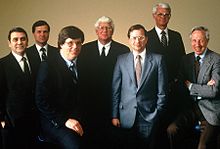ハリー・ガーランド
ハリー・ガーランド | |
|---|---|
| Harry Garland | |
 ハリー・ガーランド(2008年) | |
| 生誕 |
Harry Thomas Garland 1947年(76 - 77歳) |
| 教育 |
カラマズー大学 (B.A.) スタンフォード大学 (Ph.D.) |
| 職業 | 科学者、工学者、著述家、実業家 |
| 著名な実績 | クロメンコ社共同設立者 |
| 親 |
ハリー・G・ガーランド ローズ・ガーランド |
| コールサイン |
WA8FJW WA6VYT |
ハリー・トーマス・ガーランド(Harry Thomas Garland、1947年 - )は、アメリカ合衆国の科学者・技術者・著述家・実業家であり、クロメンコ社の共同設立者である。シリコンバレーにおけるパーソナルコンピュータ開発の歴史の中で最も重要な革新者の一人として認められている[1]。
幼年期
[編集]実業家・ハリー・G・ガーランドの子として[2]、ミシガン州デトロイトで1947年に生まれた。
スタンフォード大学
[編集]カラマズー大学から数学で学士号(B.A.)を取得して卒業し[3]、1968年にスタンフォード大学大学院へ進学した。スタンフォード大学では生物学を専攻し、随意運動の制御における人間の脳の機能に関する研究を行った[4]。彼は、随意運動時の筋活動をモニターするための筋電図法の技術を開発し[5]、筋肉の制御における脳の役割と局所反射の役割の解明に取り組んだ[6]。これにより、随意運動時の脳機能の理解が深まり、パーキンソン病治療におけるレボドパの作用機序の解明に繋がった[7]。
1972年にスタンフォード大学から博士号(Ph.D.)を取得した[3][8]。ジョン・G・リンヴィルに誘われてスタンフォード電子研究所の研究スタッフに加わり、次世代の視覚障害者用読取装置オプタコンのコンセプトを開発した[9]。1974年には、スタンフォード大学電気工学科の副学科主任に任命された。彼は大学院の電気工学の課程を担当し、マイクロプロセッサシステム設計の新分野の教科書を執筆した[10]。
『ポピュラーエレクトロニクス』誌
[編集]
スタンフォード大学在学中、ガーランドは電子工学の技術をより多くの人に知ってもらうための尽力も行った。スタンフォード大学で知り合ったロジャー・メレンと共同で、『ポピュラーエレクトロニクス』誌に、ホビイスト向けの電子工作に関する記事を6年間にわたり執筆した[11][12][13][14][15]。この間、ガーランドとメレンはUnderstanding IC Operational Amplifiers(ICオペアンプの理解)とUnderstanding CMOS Integrated Circuits(CMOS集積回路の理解)という2冊の本も出版した[16][17]。
『ポピュラーエレクトロニクス』1975年1月号で紹介されたMITS社のAltair 8800は、マイクロコンピュータ業界の幕開けとなった[18]。同じ号に、ガーランドとメレンによる固体イメージセンサに関する記事が掲載されていた[19]。翌月、彼らはスタンフォード大学の同僚テリー・ウォーカーとともに、世界初のデジタルカメラの設計を『ポピュラーエレクトロニクス』誌に発表し、そのカメラ(彼らは"Cyclops"(サイクロプス)と呼んでいた)をAltairに接続するためのインターフェイスの開発に着手した[20]。1976年1月、MITS社はAltairの周辺機器としてCyclopsを発表した[21]。
次に『ポピュラーエレクトロニクス』誌に掲載するために開発したのは、Altairとカラーテレビを接続するインターフェイス"Dazzler"(ダズラー)だった。ガーランドとメレンは、ハードウェアの設計をテリー・ウォーカーと、ソフトウェアの設計をホームブリュー・コンピュータ・クラブの仲間であるエド・ホールと協力した。Dazzlerは『ポピュラーエレクトロニクス』1976年2月号の表紙に掲載され、ガーランドとメレンはDazzlerの電子キットを販売の申し出を受けた[22]。
CyclopsとDazzlerの販売をサポートするために、ガーランドとメレンはカリフォルニア州ロスアルトスに200平方フィートのオフィスを借りてパートナーシップを結成し、2人が大学院生時代に住んでいたスタンフォード大学の寮「クロサーズ記念館」(Crothers Memorial)に因んでクロメンコ(Cromemco)と名付けた[23]。
クロメンコ
[編集]
クロメンコは1976年に法人化し、ガーランドが社長に就任した。彼は1987年の売却まで、クロメンコ社の社長を務めた。最初の製品のCyclopsとDazzlerから始まり、マイクロコンピュータを開発するようになり、業界で最も信頼性が高いと評価された[24]。クロメンコのシステムは、放送用テレビグラフィックスのシステムとして多くのテレビ局で選ばれ[25]、アメリカ空軍の作戦行動支援システムとして広く展開し[26][27]、中国では最初のマイクロコンピュータ・システムとして広く流通した[28][29]。
1980年までに、クロメンコ社はカリフォルニア州マウンテンビューに200,000平方フィートの本社兼工場を構えるまでになった。1981年には、『Inc.』誌が、クロメンコ社を米国で最も急成長している株式非公開企業のトップ10にランク付けした[30]。ガーランドは、外部からの出資を一切受け入れることなく、この成長を達成した[31]。
テレビ放送システムにおけるクロメンコ製品の成功は、Dazzlerの後継製品であるSuper Dazzler interface (SDI)によるものだった[32]。クロメンコ社の顧客であるカラーグラフィックス・ウェザー・システムズは、SDI用のソフトウェアを開発した[33]。カラーグラフィックス・ウェザー・システムズの親会社であるダイナテック社は、自社の放送部門にコンピュータとグラフィックス・システムを提供するためにクロメンコ社の買収を模索し、1987年にクロメンコ社を買収した[34]。
その後の活動
[編集]1990年、キヤノン社長の御手洗肇に招聘され、シリコンバレーにキヤノンの新しい研究開発センターの設立を手助けした[35][36]。1990年から2001年まで、同センターでヴァイスプレジデントを務めた。キヤノンでは、医療用デジタルX線撮影装置の技術を開発し、この装置を病院や放射線科の情報システムに統合するための標準化に取り組んだ[37]。
1987年から2005年までカラマズー大学の理事を務めた。1996年から2010年まで科学・数学教育のための産業イニシアチブ(IISME)の理事を務め、会長にもなった[38][39]。
2002年、妻のロバータ・J・ガーランドと共同でガーランド・アクチュアリー社を設立し、会長を務めている。
認知
[編集]ガーランドのコンピュータ業界への貢献は、数多くの書籍[3][1][23][40]やテレビ番組で認められており、Financial News Network[41]、The Personal Computer Show[42]、The Screen Savers[43]、PBSのドキュメンタリー番組"Triumph of the Nerds"[44]などに出演している。
カラマズー大学からSesquicentennial Award(150年祭賞)とDistinguished Alumni Award(優秀卒業生賞)を受賞している[45][46]。
Understanding IC Operational Amplifiers(ICオペアンプの理解)[16]、Understanding CMOS Integrated Circuits(CMOS集積回路の理解)[17]、Introduction to Microprocessor System Design(マイクロプロセッサシステム設計入門)[10]の3冊の著書がある。
20件の米国特許を取得している[47]。
脚注
[編集]- ^ a b Piscione, Deborah (2013). Secrets of Silicon Valley. Palgrave MacMillan. p. 80. ISBN 978-1-137-27917-0
- ^ “Garland Speaks For Unique Lake Township On Macomb County Board”. South Macomb News. (August 22, 1957)
- ^ a b c Levering, Robert; Katz, Michael; Moskowitz, Milton (1984). The Computer Entrepreneurs. New American Library. pp. 36–40. ISBN 0-453-00477-6
- ^ Garland, H.; R.W. Angel (1971). “Spinal and Supraspinal Factors in Voluntary Movement”. Exptl. Neurology 33 (2): 343–350. doi:10.1016/0014-4886(71)90026-4. PMID 5124954.
- ^ Garland, H.; R.W. Angel; R. Melen (1972). “A State-Variable Averaging Filter for Electromyogram Processing”. Medical and Biological Engineering 10 (4): 559–560. doi:10.1007/bf02474207.
- ^ Garland, H.; R.W. Angel; W.E. Moore (1972). “Activity of Triceps Brachii During Voluntary Elbow Extension: Effect of Lidocaine Blockade of Elbow Flexors”. Exptl. Neurology 37: 231–235. doi:10.1016/0014-4886(72)90239-7. PMID 5077560.
- ^ Angel, R.W.; W. Alston; H. Garland (1971). “L-Dopa and Error Correction Time in Parkinson's Disease”. Neurology 21 (12): 1255–1260. doi:10.1212/wnl.21.12.1255. PMID 5167317.
- ^ Stanford Alumni Association (1989). Stanford Alumni Directory Centennial Edition. p. 443
- ^ Linvill, John G. (March 1973). Final Report: Research and development of Tactile Facsimile Reading Aid for the Blind. Stanford Electronics Laboratories. pp. 24–25 6 November 2017閲覧. "Dr. Garland suggested that the Optacon could be more effective if the camera and tactile screen were incorporated into a single hand-held unit."
- ^ a b Garland, Harry (1979). Introduction to Microprocessor System Design. New York: McGraw-Hill. ISBN 0-07-022871-X
- ^ Melen, Roger; Garland, Harry (1971). “Build the Fil-oscillator”. Popular Electronics 34 (5): 58–62.
- ^ Garland, Harry; Melen, Roger (1971). “Add Triggered Sweep to your Scope”. Popular Electronics 35 (1): 61–66.
- ^ Garland, Harry; Melen, Roger (1971). “Build the Muscle Whistler”. Popular Electronics 35 (5): 60–62.
- ^ Garland, Harry; Melen, Roger (1973). “Build a Low-Cost Op Amp Tester”. Popular Electronics Including Electronics World 4 (6): 34–35.
- ^ Garland, Harry; Melen, Roger (1974). “A Single-IC Capacitance Meter”. Popular Electronics Including Electronics World 5 (2): 44–45.
- ^ a b Melen, Roger; Garland, Harry (1971). Understanding IC Operational Amplifers. Howard W. Sams. ISBN 0-672-22484-4
- ^ a b Melen, Roger; Garland, Harry (1975). Understanding CMOS Integrated Circuits. Howard W. Sams. ISBN 0-672-21598-5
- ^ Garland, Harry (March 1977). “Design Innovations in Personal Computers”. Computer (IEEE Computer Society) 10 (3): 24. doi:10.1109/c-m.1977.217669. "There is little question that the current enthusiasm in personal computing was catalyzed by the introduction of the MITS Altair computer kit in January 1975."
- ^ Garland, Harry; Melen, Roger (1975). “Solid-state Image Sensors - TV Camera Tube Successor?”. Popular Electronics 7 (2): 27–31.
- ^ Walker, Terry; Garland, Harry; Melen, Roger (1975). “Build Cyclops”. Popular Electronics 7 (1): 43–45.
- ^ Allen, Paul (2011). Idea Man: a memoir by the cofounder of Microsoft. New York: Penguin Group. p. 108. ISBN 978-1-59184-537-9. "The Altair even debuted a digital camera back in 1976."
- ^ Walker, Terry; Melen, Roger; Garland, Harry; Hall, Ed (1976). “Build the TV Dazzler”. Popular Electronics 9 (2): 31–40.
- ^ a b Levy, Steven (1984). Hackers: Heroes of the Computer Revolution. Garden City, NY: Anchor Press/Doubleday. p. 202. ISBN 0-385-19195-2
- ^ 1977 Computer Store Survey. Westlake Village: Image Resource. (1977). p. 25
- ^ “Cromemco Computer Graphics 1987”. wn.com. 2012年2月10日閲覧。
- ^ Kuhman, Robert. “The Cro's Nest RCP/M-RBBS”. www.kuhmann.com. 2012年2月10日閲覧。
- ^ “USAF will equip its tactical fighter squadrons with a mission planning system”. Aviation Week & Space Technology 126 (22): 105. (June 1, 1987).
- ^ Ost, Laura (November 9, 1979). “Cromemco Saw the Future for Computers Overseas”. The Peninsula Times Tribune: E1,E3.
- ^ Williams, Dennis A.; Lubenow, Gerald C.; Findlay-Brown, Ian (February 18, 1985). “China Looks West to Learn”. Newsweek: 84.
- ^ Ketchum Jr., Bradford W. (December 1981). “The INC. Private 100”. Inc. 3 (12): 35–44.
- ^ Mamis, Robert A. (November 1981). “Cromemco's never taken a dime from anyone”. Inc. 3 (11): 117–122.
- ^ Fox, Tom (December 1979). “Cromemco's Superdazzler”. Interface Age 4 (12): 74–77.
- ^ “Cromemco Computer Graphics 1987”. 2014年10月31日閲覧。
- ^ “Mergers and Acquisitions”. Computer World 21 (12): 108. (March 23, 1987) 1 November 2017閲覧。.
- ^ Johnstone, Bob (October 1994). “Canon, Lone Wolf”. Wired 2 (10): 147.
- ^ Kumagai, Jean (1991). “Several Japanese Corporations Establish New Labs in United States”. Physics Today 44 (2): 81. Bibcode: 1991PhT....44b..81K. doi:10.1063/1.2809989.
- ^ Garland, H.; B. Cavanaugh; S. Lavoie; R. Cecil; A. Leontiev; B. Hayes; J. Veprauskas (May 1999). “Interfacing RIS to the Modality: An Integrated Approach”. Journal of Digital Imaging 12 (2): 91–92. doi:10.1007/bf03168766. PMC 3452882. PMID 10342177.
- ^ “Emeriti Trustees”. Kalamazoo College. 22 February 2019閲覧。
- ^ “IISME Annual report”. Internet Archives. 22 February 2019閲覧。
- ^ Freiberger, Paul; Swaine, Michael (2000). Fire in the Valley: The Making of The Personal Computer (Second ed.). McGraw-Hill. ISBN 0-07-135892-7
- ^ “Cromemco Personal Computer History 1982”. 2013年2月21日閲覧。
- ^ “Cromemco Computer Graphics 1983”. 2013年2月21日閲覧。
- ^ “TSS: Homebrew Computer Club 1/16/2004 (1of4)”. 2013年2月21日閲覧。
- ^ “Cromemco Retrospective 1996”. 2013年2月21日閲覧。
- ^ “More Honors: Dr. Harry Garland”. The Peninsula Times Tribune: p. C-6. (July 31, 1983)
- ^ “Distinguished Alumni Award 1983”. Kalamazoo College. 2013年2月21日閲覧。
- ^ “USPTO Patent Full-Text and Image Database”. USPTO. 2013年2月21日閲覧。
Text is available under the CC BY-SA 4.0 license; additional terms may apply.
Images, videos and audio are available under their respective licenses.
